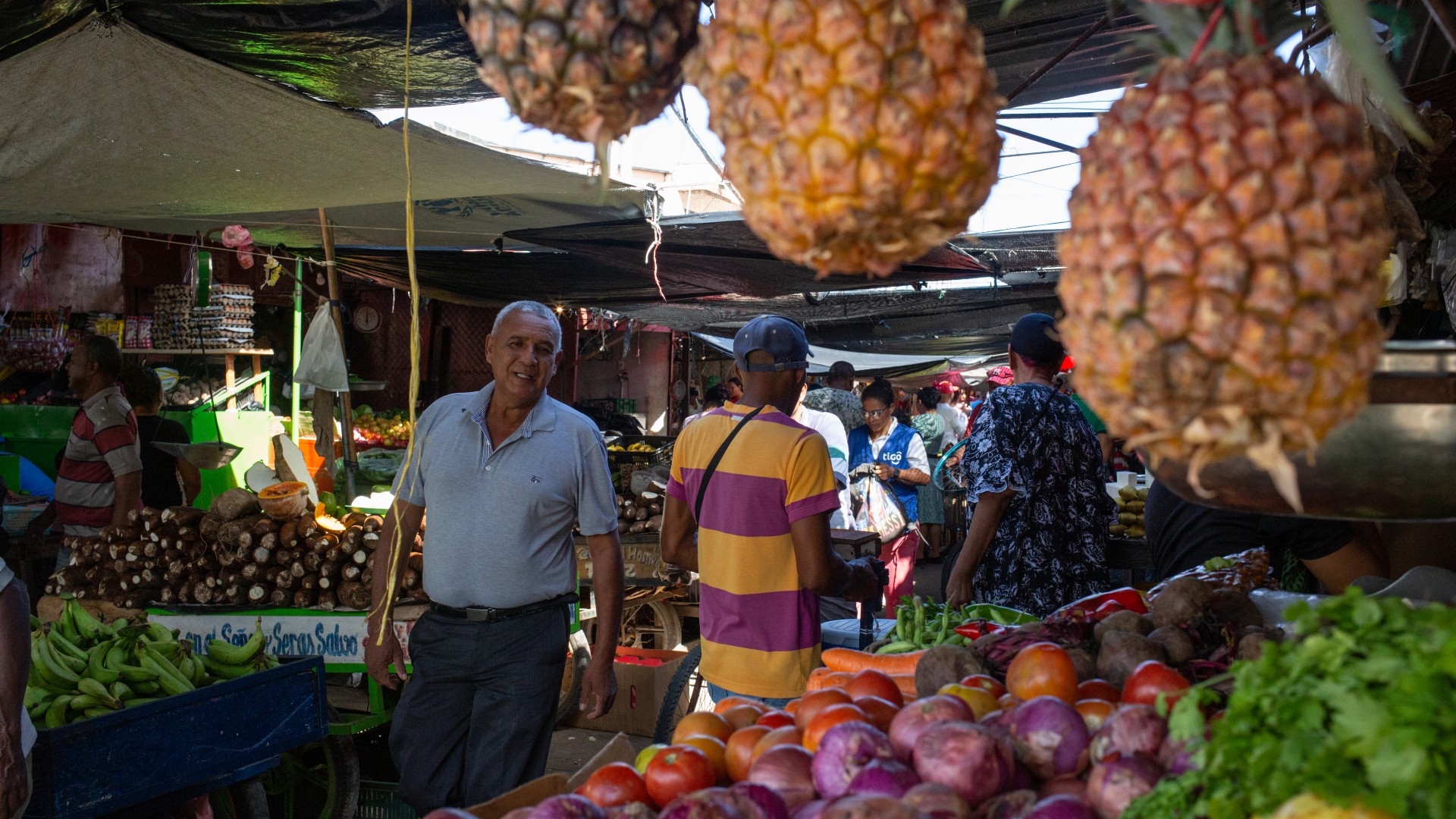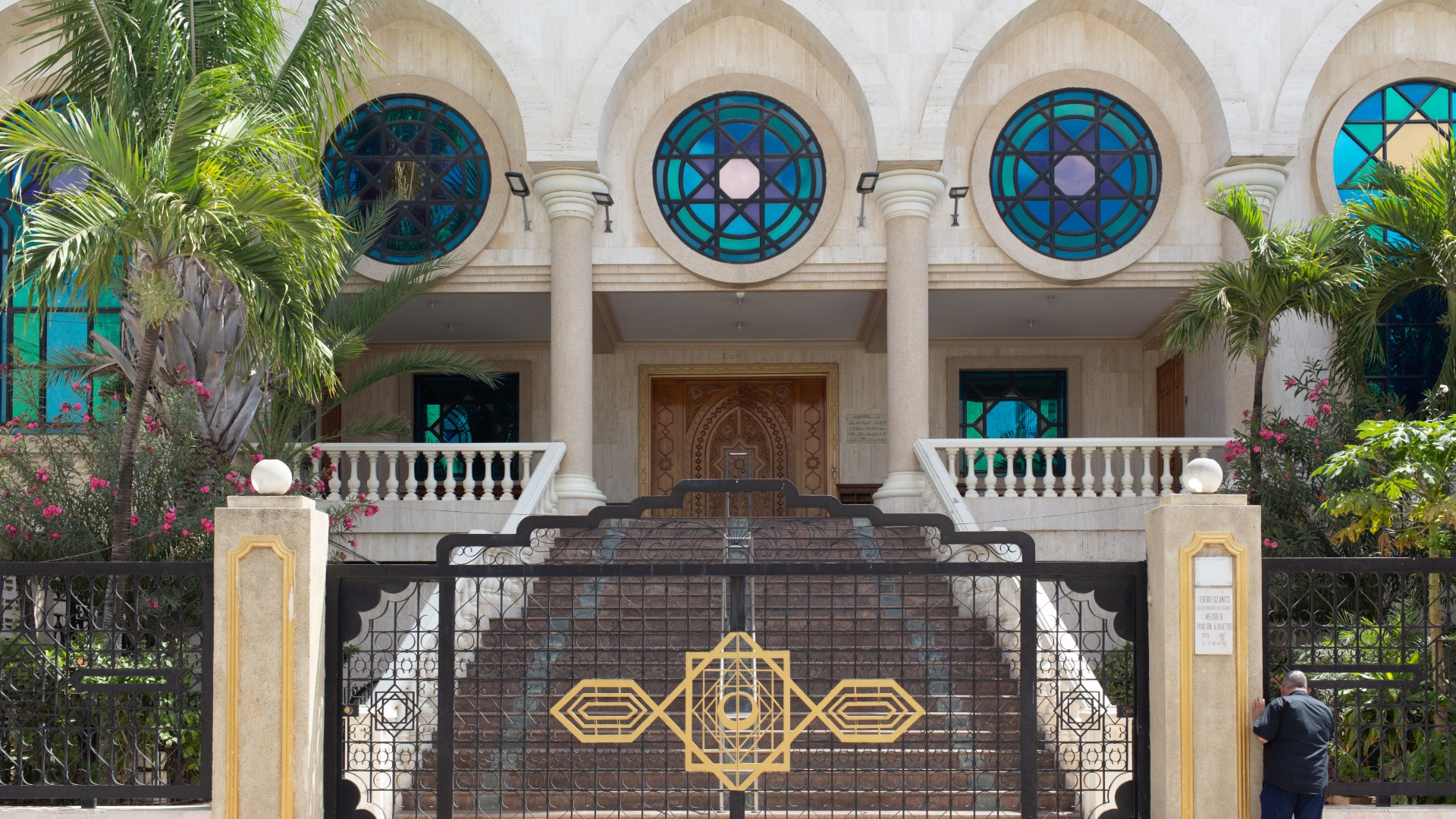From the Ottomans to the oil boom: Inside Colombia's Arab and Muslim community

On a warm Friday afternoon in western Bogota, the young imam Ahmad Gian Jimenez welcomes locals into a small prayer room on the top floor of a discreet building in a residential neighbourhood.
The afternoon sun filters into the Al-Qurtubi Centre of Islamic Studies, a simple household-come-mosque in the Colombian capital, as men arrive and scatter around the small teal room. The adhan - the call to prayer - echoes quietly through the building, as the imam readies himself for the day’s sermon.
Jimenez, just 22 years of age, sets up a ring light in front of the room's simple pulpit - known as minbar - and places a smartphone into its central holder in order to broadcast the day's prayer live on social media.
He steps up onto the minbar and closes his eyes before launching into the day’s sermon in Arabic. In front of him, a mix of Venezuelan, Jordanian, Colombian, Afghani, Argentinian and Pakistani men listen - yet some only begin to do so intently once he switches to Spanish to continue his preachings.
“Why are there Muslims in Colombia?” Jimenez asks at one point.
Stay informed with MEE's newsletters
Sign up to get the latest alerts, insights and analysis, starting with Turkey Unpacked
The Muslim community in Colombia is just a minority, unsurprising in such a heavily Catholic country, though the community is slowly but steadily growing.
This is evidenced by the number of mosques in the capital. In 2007, Bogota had just one mosque, now there are six spread across the city, with a Muslim presence in many of the city’s main urban hubs.
“In Colombia, just a few years ago, the majority of the Muslim population was a migrant population, but today the majority is a native population,” the young imam, who is dressed traditionally in a thawb with a ghutra headscarf draped across his taqiyah, tells Middle East Eye.
Arab migration to Colombia
The Arab diaspora has a long history in Colombia, with the first wave of Arab migrants arriving in the country towards the end of the 19th century, as many across the Middle East fled the Ottoman Empire.
Migrants from modern day-Lebanon, Syria and Palestine set sail in search of greater fortunes in the Americas and touched down across the Caribbean. It is believed that between 1860 and 1914, approximately 1.2 million Arabs resettled throughout the Americas from the collapsing empire.
A minority gradually trickled down to Colombia, the vast majority Lebanese, and settled predominantly in northern cities like Barranquilla and Maicao. From 1880 to 1930, it’s believed between 10,000 and 30,000 Lebanese migrants moved to Colombia.
“The Arab migration to Colombia at the end of the Ottoman Empire was relatively small and they lost a lot of their traditions and customs. The groups in Colombia were so small that there really wasn't much continuity,” says Diego Castellanos, a Colombian academic focusing on Latin American Muslim communities at the French Institute for Anatolian Studies.
That continuity came further down the line when a second wave of Lebanese migrants landed on Colombian shores throughout the 1970s. As a brutal civil war ravaged the country, many opted to leave in hope of a better life.
Encouraged by relatives and friends who had migrated previously, many Lebanese made their way to Colombia. Plenty of the newcomers settled in Maicao, a small, dusty city wedged by the Venezuelan border in northern Colombia.
“Much of the appeal that led many to Maicao was that it was a city that was still growing. Lebanese began to see Maicao as an option, it was very easy to arrive and start producing economically. As they had relatives, that helped them set up and contribute to the local economy,” Castellanos explains.
A prosperous community
Maicao quickly became the epicentre of Colombia’s Muslim and Arab community. The influx of Lebanese migrants coincided with the Venezuelan oil boom of the 1970s, which allowed the border city to thrive economically, and Arab businesses, from textiles, to perfumes and home appliances, soon became a regular and increasingly important feature of Maicao’s busy commercial streets.
This growth continued steadily for the next two decades, with the Arab community peaking in the 1990s, allegedly comprising between 5,000 to 8,000 members in the small city.
“During the 1990s Maicao had free commerce, there was more work and more opportunities. There was a really large [Arab] community,” says Nasser Gebara, a Lebanese businessman who arrived in Maicao in 1987.
Such was the strength and size of Maicao’s Arab and Muslim community that a prominent mosque was eventually built in the city. The Omar Ibn Al-Khattab Mosque, erected in 1997, is the pride and joy of the local Muslim community.
The mosque is the third largest in all of Latin America. A clean and sleek, white marble building with large stained-glass windows, and a minaret that rises over much of the small, low-rise city, it is allegedly the only mosque in Colombia with permission to broadcast the adhan publicly.
Maicao also houses the Dar El Arkam school, which features Arabic and Islam as central parts of its curriculum. Back in the 1990s, the school had between 800 to 1,200 students according to the school's headmaster - the vast majority of which had Arab roots.
Additionally, Maicao is the first and only place in Colombia to be governed by a Muslim mayor - the Lebanese-Colombian Mohamad Jaafar Dasuki - elected in 2020.
“It’s an honour to be the first mayor in the history of Maicao with Arabic, and particularly Lebanese, roots as well as belonging to the Muslim faith,” he tells Middle East Eye, his office featuring Arab decorative elements.
Illicit economy
Economic growth also brought with it a high degree of lawlessness. Maicao's prosperity was unbridled, passage across the border - both of people as well as goods - often went unchecked and soon a vibrant web of illicit economies developed in Maicao’s underbelly throughout the 1980s and 90s .
“It is a town where the border situation with Venezuela means that a lot of legal trade passes through there, but at the same time it is a place where all the illegal border economies between Colombia and Venezuela begin to come together: drug trafficking, money laundering, and contraband began to grow and the state was not going to exercise real control,” says Castellanos.
With such trade came increased criminality, as armed groups battled for control of the area throughout the mid-1990s, often resorting to kidnappings and extortion of Maicao’s prominent business community. At this point, many of the city's businesses were targeted, including the Arabs in the area.
The growth of Maicao’s Arab community was soon cut short. Venezuela’s economic demise at the turn of the century brought much of the economic activity across the border to a grinding halt, plus the government increased its regulation on local imports and border crossings, further constraining economic growth.
The dwindling economic opportunities that brought many Arabs to Maicao quickly dried up, and the added element of increased insecurity led many to flee the city and resettle elsewhere.
Venezuela’s ongoing economic crisis has left Maicao, and its once prosperous Arab community, in a rut.
This is reflected in the Dar El Arkam school’s current student body, which last year was as low as 147 students, just a tenth of what it was at the community’s height.
The Arab population has declined across the city as a whole, with an estimated 1,000 Arab residents remaining in Maicao. Some of the Arabs went to the Colombian port city of Barranquilla, which is also home to a small Arab community, while others ventured out to the Caribbean or Panama, some crossed over to Venezuela, and some returned home to Lebanon or other areas of the Middle East.
'We have the hope that things will recover again and that is what has kept us here, enduring the difficult situation'
- Nasser Gebara, Lebanese businessman
“I see a community in crisis,” says Pedro Delgado, a researcher into the local Arab community and a Colombian convert to Islam.
“Back then Maicao was very important in terms of the country's Muslim and Arab population. However, the economic and security conditions pushed people to go elsewhere. Maicao lost its status as a representative of the Arab community,” Delgado says.
Those who stayed behind have grown to form an integral part of the city’s social fabric and, despite the troubles, hope to see their community and the Arab diaspora flourish locally once more.
“We have the hope that things will recover again and that is what has kept us here, enduring the difficult situation. Hopefully this comes back to life again and we can grow again,” Gebara says.
Middle East Eye delivers independent and unrivalled coverage and analysis of the Middle East, North Africa and beyond. To learn more about republishing this content and the associated fees, please fill out this form. More about MEE can be found here.








